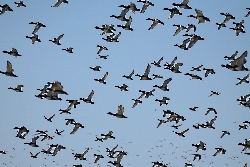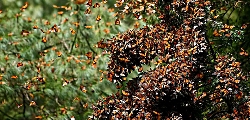
Courtesy US FWS
Nate Rathbun, Photographer
In these weather-changing conditions, wildlife species have four options: adapt to colder weather, migrate to better conditions, hibernate…or die. Today, we’ll consider migration.
As recorded by the National Geographic Society, Entomology Professor Emeritus, Hugh Dingle, mentions five basic characteristics of migration:
Prolonged movements that carry animals outside familiar habitats.
- They tend to be linear, not zig-zag patterns.
- They involve special behaviors of preparation and arrival (such as overfeeding).
- They demand special allocations of energy.
- They maintain attention to the greater mission. Meaning they are undistracted by temptations, and undeterred by challenges, that would turn other animals aside.
- They feel they can eat, rest, or mate later.
The entire migration movement involves body shape, physical processes, and genetics of each species.
For ten years, scientists have been documenting one of the largest aerial mass migrations on earth. According to Science Magazine, three and one half trillion insects were recorded on radar traveling from southern England to Africa and back. They represented 3,200 tons of biomass (living tissues), which was more than seven times that of the thirty million songbirds that make that same annual flight.
Movements don’t have to be monumental to be considered migratory. For instance, some consider the daily changes in depth of ocean zooplankton to be a form of migration. They spend the day near the surface benefiting from the food provided by sunlight, then sink to darker depths at night to hide.
Some rattlesnakes in Western Canada are also considered migratory as they have been tracked to relocate anywhere from 5 to 33 miles each year. This movement is spurred by cold temperatures which reduce food, and a scarcity of good den sites below the earth’s surface, which must be warm enough and at times capable of holding up to 1,000 snakes. In contrast, Arizona rattlers travel far less because they don’t require that need.
Pronghorns, which are not really antelopes, travel far and fast, around 60 miles per hour. One group travels hundreds of miles from north-central Montana up into Alberta for breeding in the Spring. Another group of nearly 20,000 goes from Grand Teton National park south to the sagebrush plains near Pinedale, Wyoming for the winter. The routes of both groups do not vary, which can be hazardous if they are blocked by snows.
Biodiversity of ecosystems and processes, which enable each species to survive, is critical. But Conservation scientists also try to preserve migrational behaviors.

Courtesy FWS
Pablo Leutaud, Photographer
Licensed under Creative Commons
*Salmon and Caribou also migrate 3,000 miles.
*Dragonflies will go 10,000 miles.
*Leatherback turtles swim 12,000 miles.
*Elephant seals and Humpback whales swim over 13,000 miles.
*For birds, Northern Wheatears and Pectoral Sandpipers fly 18,000 miles.
*Sooty Shearwaters fly from the Falkland Islands to Arctic waters, a roundtrip of 40,000 miles.
*The champion distance migrant, the Arctic Tern, flies 44,000 miles from the Arctic north of Greenland to Antarctica every year!
*And the longest nonstop flight goes to the Bar-Tailed Godwit at over 7,000 miles from Alaska to New Zealand in nine consecutive days!
An entire program could also be dedicated to human migrations including various Native American tribes, the Nenets who herd reindeer 400 miles in the Russian Yamal Peninsula, and the ancient people who crossed the Bering Strait to settle in the Americas.
As we close this session of Fall migrations, consider the words of George Eliot who wrote
the following in 1841: “Delicious Autumn. My very soul is wedded to it. And if I were a bird I would fly about the earth seeking the successive Autumns.”
This is Ron Hellstern for Wild About Utah
Credits:
Images: Readhead Ducks, Courtesy US FWS, Nate Rathbun, Photographer; Monarchs in Mexico, Courtesy US FWS but licensed under Creative Commons, Pablo Leutaud, Photographer
Text: Ron Hellstern, Cache Valley Wildlife Association
Additional Reading
https://www.fws.gov/midwest/news/monarchpopulation2016.html
https://www.fws.gov/radar/migration/index.html
https://whc.unesco.org/en/list/1290
https://blog.nature.org/science/2014/02/26/cornfield-monarch-butterfly-decline-pollinators-agriculture/
https://www.nationalgeographic.org/news/snake-migration/
https://news.nationalgeographic.com/news/2006/08/060808-bird-migration.html
NRCS Working Lands for Monarch Butterflies, https://arcg.is/0TjueO
